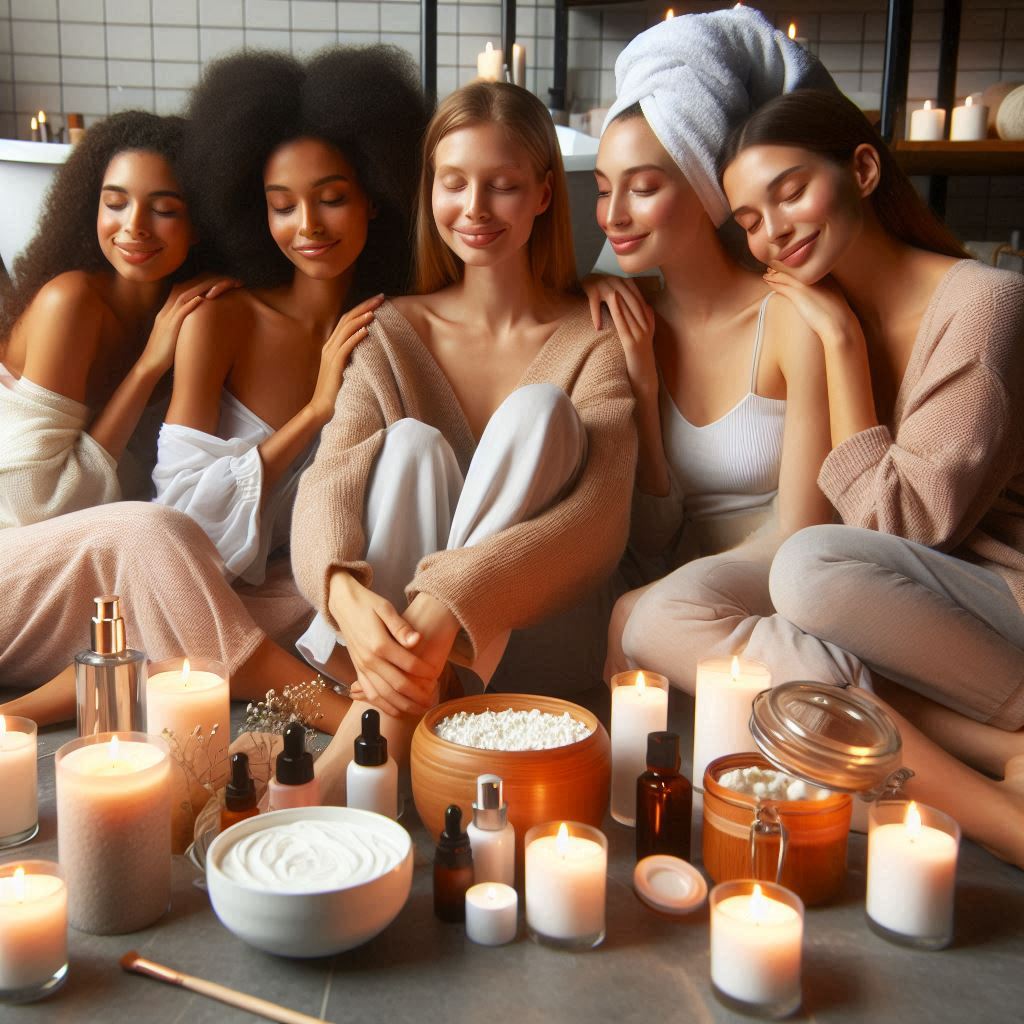In today’s fast-paced world, taking time for self-care is essential. A beauty self-care routine can help you feel and look your best.
Beauty self-care is more than just a trend; it’s a vital part of maintaining overall well-being. When you dedicate time to your beauty regimen, you nourish your skin, boost your confidence, and enhance your mood. Establishing a routine that works for you can transform your daily life.

Whether it’s a simple skincare routine or a more elaborate pampering session, the key is consistency and personalization. By understanding the basics and finding what suits your skin and lifestyle, you can create a routine that not only improves your appearance but also promotes inner peace and relaxation. Dive in to discover how to craft your perfect beauty self-care routine.
Introduction To Beauty Self Care
Creating a beauty self care routine is essential for your overall well-being. It is not just about looking good. It is about feeling good too. A regular self care routine can help you relax, de-stress, and boost your confidence. This blog post will guide you through the importance and benefits of self care for your skin.
Importance Of Self Care
Self care is vital for maintaining physical and mental health. It gives you time to focus on yourself. This can be as simple as a skincare routine. Taking care of your skin can improve your mood. It can also help you feel more confident and positive. Investing in self care can lead to a happier and healthier you.
Benefits For Skin
A beauty self care routine can offer many benefits for your skin. It helps keep your skin clean and clear. Regular cleansing removes dirt and impurities. This prevents clogged pores and breakouts. Hydration is also crucial. Using a good moisturizer can keep your skin soft and supple. This can reduce the signs of aging. Your skin will look fresh and glowing with consistent care. Taking the time for self care can make a noticeable difference.
Assessing Your Skin Type
Creating a beauty self-care routine starts with knowing your skin type. Understanding your skin helps you pick the right products. This ensures your routine benefits your skin the most.
Identifying Skin Types
There are different skin types: oily, dry, combination, and sensitive. Oily skin looks shiny and may have larger pores. Dry skin feels tight and may flake or have rough patches. Combination skin has both oily and dry areas. Sensitive skin gets easily irritated and may show redness.
To identify your skin type, wash your face and wait for an hour. Check how your skin feels and looks. If it feels greasy, you likely have oily skin. If it feels tight or rough, it’s probably dry. A mix of both indicates combination skin. If it gets red or itchy, you might have sensitive skin.
Tailoring Routine To Skin Type
Once you know your skin type, you can tailor your routine. For oily skin, use a gentle cleanser and oil-free moisturizer. This helps control shine and prevent breakouts. Dry skin benefits from a hydrating cleanser and a rich moisturizer. This helps keep your skin soft and smooth.
Combination skin needs a balanced approach. Use products that hydrate dry areas without making oily areas greasy. Sensitive skin needs gentle, fragrance-free products. Look for soothing ingredients like aloe vera and chamomile.
By tailoring your routine to your skin type, you can achieve healthier, glowing skin. This ensures your self-care routine is effective and enjoyable.

Daily Cleansing Routine
A daily cleansing routine is essential for keeping your skin healthy and glowing. It removes dirt, oil, and impurities that build up during the day. This helps prevent breakouts and keeps your complexion clear. Let’s dive into the steps you need to follow for an effective cleansing routine.
Choosing The Right Cleanser
The first step in your routine is to choose the right cleanser. This ensures you are removing the day’s grime without damaging your skin. Here are some tips for selecting the best cleanser:
- Skin Type: Consider your skin type—oily, dry, combination, or sensitive.
- Ingredients: Look for ingredients that suit your skin’s needs.
- pH Balance: Opt for a cleanser with a pH close to your skin’s natural level.
Steps For Effective Cleansing
Follow these steps to ensure your skin is thoroughly cleansed and ready for the next steps in your routine:
- Wet Your Face: Use lukewarm water to wet your face. This opens up your pores.
- Apply Cleanser: Take a small amount of cleanser. Gently massage it onto your face in circular motions.
- Rinse Thoroughly: Rinse your face with lukewarm water. Make sure no residue is left.
- Pat Dry: Use a soft, clean towel to pat your face dry. Do not rub.
Consistency is key. Make this daily cleansing routine a habit. Your skin will thank you.
Exfoliation Techniques
Creating a beauty self-care routine involves many steps. Exfoliation is one of the essential techniques. It helps remove dead skin cells, leaving your skin fresh and smooth. Let’s explore some effective exfoliation techniques to enhance your beauty routine.
Types Of Exfoliants
There are two main types of exfoliants: physical and chemical. Physical exfoliants use small grains or brushes to scrub away dead skin cells. Examples include sugar scrubs and exfoliating gloves.
Chemical exfoliants use acids or enzymes to dissolve dead skin cells. Common acids include glycolic acid, salicylic acid, and lactic acid. Enzyme exfoliants are gentler and often use natural ingredients like fruit enzymes.
How Often To Exfoliate
Exfoliating too often can damage your skin. For most skin types, exfoliating 1-2 times a week is enough. If you have sensitive skin, once a week is best. If you have oily or acne-prone skin, you might exfoliate up to three times a week.
Listen to your skin. Adjust the frequency based on how your skin reacts. Always follow with a moisturizer to keep your skin hydrated.
Moisturizing Essentials
Moisturizing is a key step in any beauty self-care routine. It helps keep your skin hydrated, soft, and glowing. A good moisturizer can make a big difference in your skin’s appearance and health. In this section, we’ll explore the essentials of moisturizing, including how to select the right moisturizer and the best application tips.
Selecting A Moisturizer
Choosing the right moisturizer for your skin type is important. Not all moisturizers are created equal. Here are some tips to help you make the best choice:
- Identify your skin type: Is it oily, dry, combination, or sensitive?
- Look for key ingredients: Hyaluronic acid, glycerin, and ceramides are great for hydration.
- Check for allergens: If you have sensitive skin, avoid fragrances and harsh chemicals.
- Consider the texture: Creams are thicker and better for dry skin. Lotions are lighter and good for oily skin.
To summarize, understanding your skin’s needs is the first step in selecting the right moisturizer. Pay attention to ingredients and texture to ensure you get the best results.
Application Tips
Applying your moisturizer correctly can enhance its effectiveness. Follow these tips for the best results:
- Cleanse your face: Always start with a clean face to remove dirt and oil.
- Use the right amount: A pea-sized amount is usually enough. Too much can clog pores.
- Pat, don’t rub: Gently pat the moisturizer into your skin to avoid irritation.
- Apply to damp skin: Moisturizers work best on slightly damp skin. This helps lock in moisture.
- Don’t forget your neck: Your neck needs moisture too. Apply gently in upward strokes.
By following these application tips, you can ensure your skin gets the most benefit from your moisturizer. Remember, consistency is key. Make moisturizing a daily habit for the best results.
Sun Protection Strategies
Protect your skin with daily sunscreen. Choose SPF 30 or higher for best results. Wear hats and sunglasses to shield your face.
Creating a beauty self-care routine means paying attention to skin health. An essential part of this is protecting your skin from the sun. Sun protection helps prevent premature aging, skin damage, and even skin cancer. Below, we discuss the importance of sunscreen and best practices for sun protection.
Importance Of Sunscreen
Sunscreen is vital for maintaining healthy skin. It shields your skin from harmful UV rays. These rays can cause sunburn, dark spots, and wrinkles. Using sunscreen daily can reduce the risk of skin cancer. It also helps keep your skin looking young and vibrant.
Best Practices For Sun Protection
Apply sunscreen every day, even on cloudy days. Choose a broad-spectrum sunscreen with SPF 30 or higher. Reapply it every two hours, especially after swimming or sweating. Wear protective clothing like hats and long sleeves. Seek shade during peak sun hours, usually between 10 a.m. and 4 p.m. Don’t forget your sunglasses to protect your eyes. Stay mindful of reflective surfaces like water, sand, and snow. They can increase your exposure to UV rays.
“`
Incorporating Serums
Incorporating serums into your beauty self-care routine can bring many benefits. These potent products often contain concentrated ingredients that address specific skin concerns. For example, hydration, aging, or uneven skin tone. Adding serums to your regimen can enhance your skin’s overall health and appearance.
Benefits Of Serums
Serums offer targeted solutions. They penetrate deeper into the skin compared to regular moisturizers. This deep penetration allows for better absorption of active ingredients. Serums can help with hydration, reducing fine lines, and evening out skin tone. They are lightweight and non-greasy, making them suitable for all skin types. Regular use can lead to noticeable improvements in skin texture and clarity.
How To Apply Serums
Applying serums correctly ensures maximum benefits. Start with a clean face. Wash your face with a gentle cleanser. Pat your skin dry with a soft towel. Next, apply a toner if you use one.
Take a small amount of serum. Usually, a few drops are enough. Gently spread the serum over your face and neck. Use your fingertips to massage it in. Let the serum absorb fully before applying other products. This step helps lock in the serum’s active ingredients. Follow with a moisturizer to seal in the benefits.

Nighttime Skin Care Routine
Establishing a nighttime skin care routine is essential for maintaining healthy skin. Your skin repairs itself during sleep. This is why using the right products and following a consistent routine is crucial. Below, we’ll explore the best nighttime products and the steps for an effective overnight skin care routine.
Nighttime Products
Choosing the right nighttime products can make a significant difference in your skin’s health. Here are some must-have items:
- Cleansers: A gentle cleanser removes dirt and makeup.
- Serums: Look for serums with retinol or hyaluronic acid.
- Moisturizers: Use a rich, hydrating moisturizer.
- Eye Creams: Target dark circles and puffiness.
- Face Oils: Add an extra layer of hydration.
Steps For Overnight Skin Care
Follow these steps for an effective overnight skin care routine:
- Cleanse: Use a gentle cleanser to remove impurities.
- Tone: Apply a toner to balance your skin’s pH.
- Serum: Apply a serum suited to your skin type.
- Moisturize: Use a rich moisturizer to lock in hydration.
- Eye Cream: Gently pat an eye cream around your eyes.
- Face Oil: Add a few drops of face oil for added moisture.
Consistently following these steps can lead to radiant and healthy skin. Your skin will thank you!
Healthy Lifestyle Choices
Creating a beauty self-care routine goes beyond just skin products. Healthy lifestyle choices play a big role. They impact your skin, hair, and overall well-being. Let’s dive into key areas that support your beauty routine.
Diet And Hydration
What you eat matters for your skin. A balanced diet with fruits and vegetables helps. These foods provide essential vitamins and minerals. They support skin health and repair.
Hydration is equally important. Drink enough water each day. It keeps your skin moisturized and glowing. Avoid sugary drinks and excessive caffeine. These can dehydrate your skin.
Exercise And Sleep
Regular exercise benefits your skin and body. It improves blood circulation. This brings more oxygen and nutrients to your skin. Exercise also reduces stress, which can cause breakouts.
Quality sleep is crucial. Aim for 7-8 hours each night. During sleep, your body repairs itself. This includes your skin. Lack of sleep can lead to dull skin and dark circles.
Frequently Asked Questions
How Do I Start A Beauty Self Care Routine?
Begin with cleansing your face daily. Follow with moisturizing and applying sunscreen. This establishes a basic routine.
What Are Essential Products For A Beauty Routine?
Essential products include a gentle cleanser, a moisturizer, sunscreen, and a night cream. These basics ensure healthy skin.
How Often Should I Exfoliate My Skin?
Exfoliate your skin 1-2 times a week. This helps remove dead skin cells and promotes a glowing complexion.
What Benefits Does A Beauty Self Care Routine Offer?
A routine improves skin health, boosts confidence, and reduces stress. Consistency leads to visible, long-term results.
Conclusion
Crafting a beauty self-care routine is essential. It helps you feel good. You can start small and build habits over time. Consistency matters more than perfection. Pay attention to what your skin and body need. Find joy in the process.
Remember, self-care is about you. Make it simple and enjoyable. Your well-being deserves it. By following these tips, you can maintain a balanced routine. Keep yourself at the center of your self-care journey. Enjoy every step along the way.

